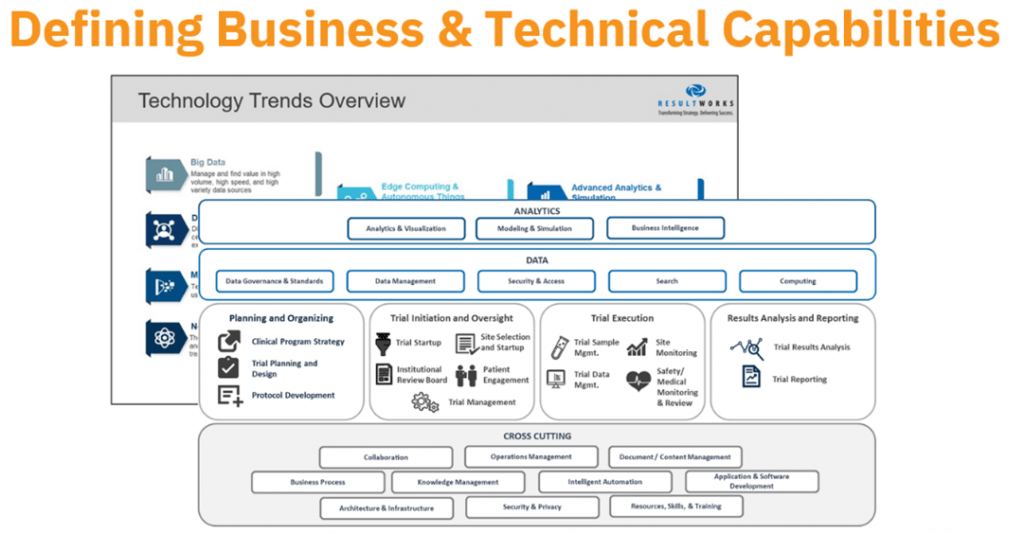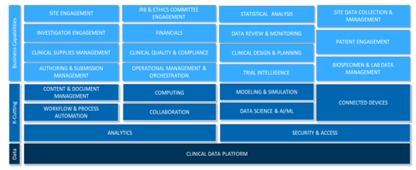
Clinical Development Transformation – The 6 Key Strategy Steps

To successfully perform a transformation of Clinical Development to improve efficiency and effectiveness, there needs to be both a business and technology strategy that enables the process. There are six important steps that ResultWorks, an Astrix business, follows in order to ensure our client’s success in this area.
1. Guiding Elements
First, we are looking at defining the strategic direction for the strategy setting. Part of this involves the guiding principles of the organization, the vision, key business imperatives, the key platforms for the clinical area, as well as the key issues that are being faced by the organization to ensure they are addressed through the strategy setting.
Defining all of these elements upfront, including the guiding principles, which might include how we define and view the architecture, the data or information, and how the organization wants to deliver the user’s experience, is the first step. These guiding elements clarify and drive the decisions regarding the strategy.
2. Capabilities Definition

Diagram 1
Reviewing the business and technical capabilities in the clinical development space is the next step in the process. In this phase the core business processes and all the cross-cutting capabilities are evaluated through our framework (Diagram 1). This is done operationally as well as from a data and an analytics perspective. The technology trends and emerging technologies that are known, and which we need to incorporate are all brought together. Leveraging the framework, the key capabilities for the organization are identified. These capabilities are reviewed as to how they relate to the different parts of the process and needs of the business. This is assessed from both the perspective of the capabilities and processes that are foundational to clinical operations, along with the aspirational capabilities that we want for the future. This leads to a discussion regarding the issues, gaps, and opportunities. With respect to issues and gaps, the conversation is on how to resolve them or to ensure that they are not built back into the future state architecture and road map.
3. Conceptual Architecture

Diagram 2
Using the capabilities as a basis the conceptual technical architecture is developed. This is typically done from a platform perspective (diagram 2). Through this process, the capabilities to support both foundational and aspirational requirements are built in.
Additionally, the cross-cutting requirements as well are also included (i.e. above data layer). The cross-cutting requirements are those that go across multiple areas of the business. For example, clinical development organization’s data may have a cross-cutting platform that could be used by the biostats area, the clinical data management (CDM) area, as well as clinical operations. In this scenario all those groups are able to access and use common platforms rather than building their own.
And then there are the more transactional systems, business capabilities, at the top of the conceptual technical architecture. Those platforms support specific needs within the business.
4. Business Priorities
Once the capabilities and platforms have been defined, the strategic step in the process begins, which involves defining the high priority capabilities. These are resources that must be there on day one regardless as to how the group weighs in on the priorities. These are foundational to the clinical development operations.
These capabilities can be built in an extensible way where you start small and build out, however, they still need to be there. Then a prioritization of the greatest need in this area needs to be determined. This is from a pure business perspective. It also has to be tempered with the urgency aspect. For example, a specific capability may be a high priority, however, we already have that area fairly built out, therefore, it can be used while we’re developing other areas that are more urgent for us to focus on in our roadmap, since there’s no solution currently in use. This prioritization process looks at both the business priorities and the urgency from a technology perspective.
5. Strategic Technology Assessment
As in the case with most organizations, there are existing solutions in place. Therefore, in parallel to performing the capabilities determination, a systems assessment of the organization’s current clinical development systems is performed. This involves understanding the current and existing architecture. At this step, it is determined how the existing architecture will fit with the conceptual architecture with consideration for the future. This involves a rationalization that feeds into the roadmap effort. A determination needs to be made whether the organization will continue with this technology and invest in it further or if it will just be maintained with no further investment. This determination will be based on whether there is another solution available that is coming in the near future which will replace it, or that this capability will no longer be required in the future. After this is completed, the organization’s business priority and urgency are both reviewed once again.
The final aspect regarding technology assessment is understanding the vendor solution landscape. This involves evaluating both the organization’s current solutions, commercial solutions, and applicable emerging technologies. These vendors may have a comprehensive offering in the clinical space, or provide non-clinical solutions which offer additional insight to assist in fulfilling the organization’s requirements with a holistic solution.
6. Strategic Roadmap
All of these steps culminate in the development of a high level strategic roadmap. Typically, the roadmap is broken down into three primary areas. One is a high level summary overview which is usually workstream driven. These workstreams can tie to a variety of different mechanisms that can be either organizational, based on product lines if the organization has product line set up, or based on business outcomes the organization wants to achieve. The outcomes developed in the high level roadmap drill down into deeper and deeper levels of detail. For example, detailed work descriptions that serve as a preliminary charter for the project and for implementations that can help spin up workstreams within the right time and not lose strategic intent.
The roadmaps are built to be living documents that evolve overtime as technology continues to change. By using a platform data centric model for your strategy and future ecosystem, it facilitates a rapid adjustment to incorporate new technologies and also enables the organization to support those from a business capability perspective.
Transformation Requires Alignment
In order to ensure a successful project, the organization needs to have the key constituents involved throughout the project. It’s important to get alignment along the way. The leadership of the organization sets the tone, drives through the business imperatives, and ensures they are well understood. Also critical is communicating decisions and intent along the way. Additionally, continuing to prioritize in terms of capabilities, technology, and urgency so that all those areas get factored into the alignment process.
The key is that the organization ensures that all stakeholder’s voices are heard and accounted for. It is also important to be transparent in decision making, prioritization, and the development of the strategic roadmap. To be successful everyone needs to be part of the process and aligned to support the strategy. This alignment needs to continue through the implementation and as the strategy evolves.
Summary
First and foremost, everyone needs to be aligned around the Guiding Elements associated with the program. Based on those Guiding Elements, the required critical capabilities are then defined for Clinical Development. From there, we generate a conceptual architecture and then prioritize where the greatest need is for the business. As part of the process, the strategic vendors and partners are reviewed as to how they might contribute to the future organization. We then use all of that information to help pull together a strategic roadmap.
Alignment among the business, technology, and external stakeholders is critical for a clinical transformation to be successful.
Why it Matters to You
A successful digital transformation effort across Clinical Development requires both business and technology involvement and a comprehensive approach which enables the process. In this blog we discussed:
- What are the key steps in the process to ensure a successful transformation.
- Key aspects related to the people, process, and technology.
- The importance of alignment from leadership and throughout the organization.
Case Study: LabWare Centralized Data Review for a Global Biopharmaceutical Company
Overview A global biopharmaceutical company specializing in discovery, development,... LEARN MOREWhite Paper: Managing Data Integrity in FDA-Regulated labs.
New White Paper LEARN MORELET´S GET STARTED
Contact us today and let’s begin working on a solution for your most complex strategy, technology and staffing challenges.
CONTACT US



